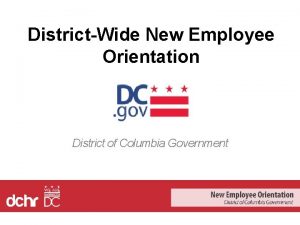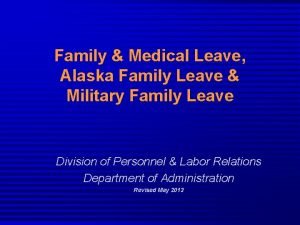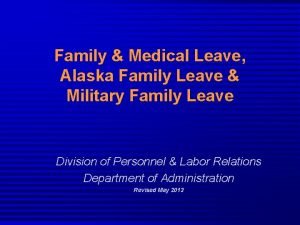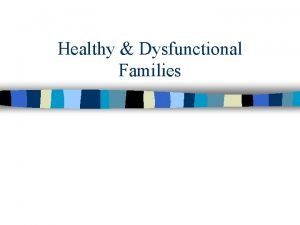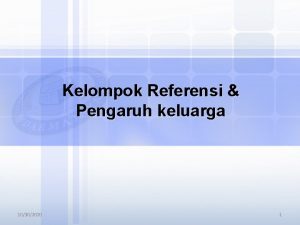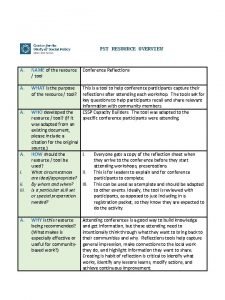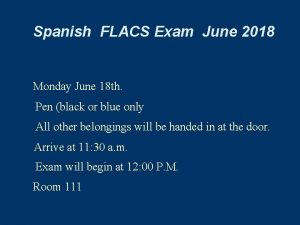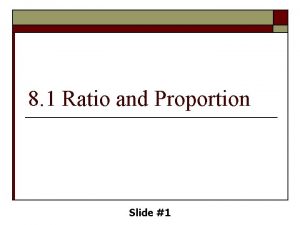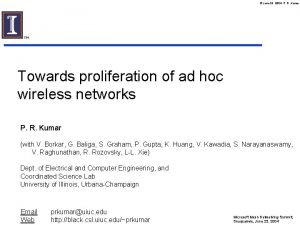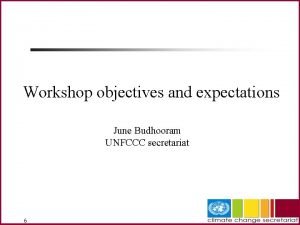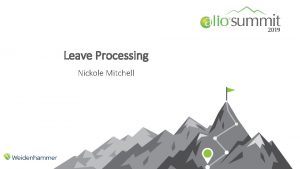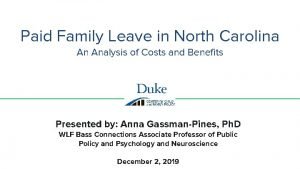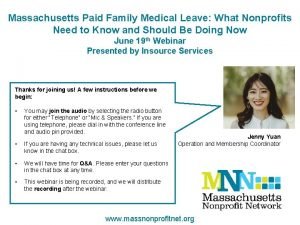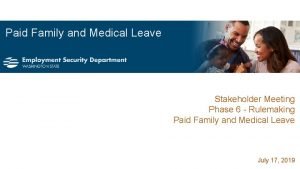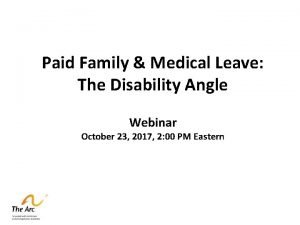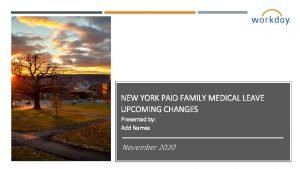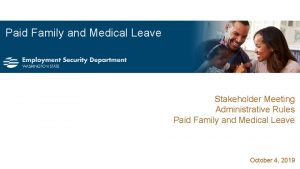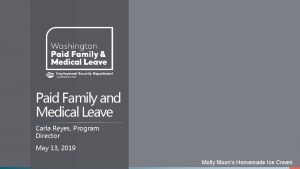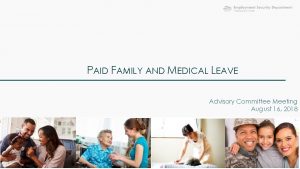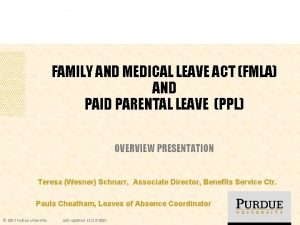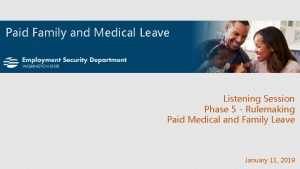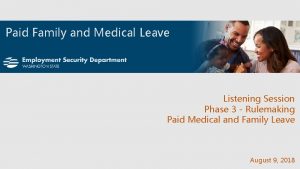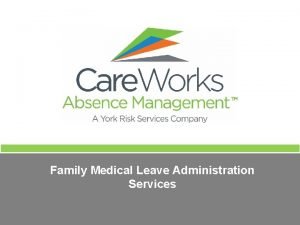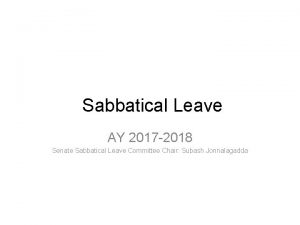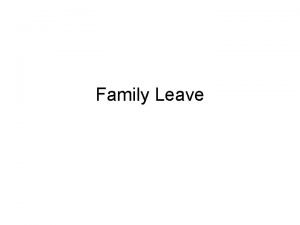Paid Family Leave Discussion June 22 2017 Paid























- Slides: 23

Paid Family Leave Discussion June 22, 2017

Paid Family Leave Discussion “Washington legislators approved a paid family and medical leave insurance program to provide employees with a portion of their wages when they need to be away from work to care for a new baby or sick family member. However, the program has never been funded. Do you support or oppose funding this program? ” (Q 2) 2

Support for Funding Paid Family & Medical Leave: Key Subgroups (1) Support No opinion Oppose Net support 68% 10% 21% +47% Seattle 80% 15% 5% +75% Non-Seattle King Co. 73% 4% 22% +51% Kitsap/Pierce/Snohomish/Thurston Cos. 68% 10% 22% +46% Other West 67% 11% 22% +45% East 60% 12% 28% +32% Men 60% 10% 31% +29% Women 76% 10% 13% +63% 18 -34 78% 10% 12% +66% 35 -54 65% 12% 24% +41% 55 -64 73% 5% 22% +51% 65+ 66% 13% 22% +44% Republicans 42% 15% 42% -- Independents/others 64% 11% 25% +39% Democrats 92% 5% 3% +89% All Region Gender Age Party ID

Paid Family Leave Discussion 4

Paid Family Leave Discussion 5

Paid Family Leave Discussion 6

Tentative Agreement Reached • Walk through details of the proposal • Provide examples of how program will work 7

Cost Share Summary of agreement - Cost Total estimated cost of the program is. 3% -. 5% of payroll Two separate funds are established Paid Family Leave fund – approximately 1/3 of the cost of the program • 100% funded by the employee • Funds: -Child bonding, ill family member, military exigency Disability/Medical fund – approximately 2/3 of the cost of the program • 55% paid by the employer, 45% paid by employee • Total employer contribution is 37% (. 111% -. 185% of payroll) • Funds: -Employee’s disability, including pregnancy Example: Minimum wage employee - $0. 015/hr, 30 hours/week - $0. 45/week, $23. 38/year Example: Average wage employee - $0. 03/hr, 40 hours/week - $1. 20/week, $62. 45/year Example: $1 million annual payroll - $1, 110/year [PERCEN TAGE] Employer Employee [PE RC EN TA GE]

Summary of Agreement – Who is covered • All employees who have worked for any employer(s) for 820 hours in 4/5 previous quarters v 820 hours = 5 months at full time, 15 hours/week for the full year • Employees who work for an employer with fewer than 50 employees are covered and pay in to the fund, employer does not • Small employer with fewer than 50 employees may choose to opt in • Independent contractors and self employed may opt it 9

Summary of Agreement – Business incentives • All employers, small and large, opted in to the program or not will receive protection from Unemployment Insurance charges due to hiring a temporary employee • Businesses with < 150 employees, and have opted in to the program are eligible for a $3, 000 payment to cover the cost of a temporary employee. Capped at $30, 000 per year • Businesses with <150 employees, and have opted in to the program can choose to retrain an employee internally and will be eligible to receive reimbursement for actual costs up to $1, 000 (costs can include training, overtime, etc. ) • Employers who already provide comparable benefits may seek a waiver if they choose to continue their own plans 10

Summary of Agreement – Length of Benefit • Employees who are eligible (worked at least 820 hours in the workforce in 4/5 last quarters) may access paid leave for qualifying events: v 12 weeks for family care v 12 weeks for personal medical/disability v Capped at a total 16 weeks per 12 month period v A person who experiences disability related to pregnancy is eligible to take 14 weeks of disability, for a total of 18 weeks per 12 month period We will walk through how this works later. 11

Summary of Agreement – Qualifying Events • Eligible employees may take leave if they have a qualifying event that is medically certified. • Family Leave: v Birth, adoption, placement of a child (either parent) v Serious illness of a family member, requires treatment or care Parent, Parent-in-law Grandparent Spouse Sibling Child Grandchild v Military Exigency • Medical/Disability Leave v Employee’s personal and serious medical issue or disability v Includes recovering from child birth or pregnancy related complications 12

Summary of Agreement – Employer Requirements Job Retention benefit: • While all qualified employees are eligible to take leave, the employer does not have any additional benefits beyond what is already required FMLA • Employers with > 50 employees • Must reserve position for an employee if they have worked with that employer for at least 12 months, and have worked 1250 hours with that employer • Must continue health care benefits while FMLA covered employee is out 13

Summary of Agreement – Wage Replacement • Qualified employees who take PFL are entitled to a portion of their wages, calculated: • 90% of wages up to 50% of the state’s average weekly wage v Average weekly wage is set annually by the state, currently $1082, or $56, 264/yr v Employees making $13. 50 will receive 90% of their wages • Then, 50% of wages beyond • No one will receive more than 90% of the AWW, ($1, 000) • Example: Employee makes $60, 000/year or $1, 153. 84/week v 50% of the AWW is = $541, they receive 90% = $486. 90 v Plus, 50% of the rest of his or her wages, $1, 153. 84 – 541 = $612. 84, $612. 84 x 50% = $306. 42 v $486. 90 + $306. 42 = $793. 32, 68% of his or her wages 14

Summary of Agreement – Statewide program • This is a STATEWIDE program, administered by Employment Security Department • Key aspect of this program is the portability for workers, which does not function without statewide consistency • Local governments will be prohibited from enforcing, mandating separate program 15

Summary of Agreement – Questions Next: How Does it work?

How Does it Work? Small business, has not opted in to the program Jane works 40/week 14 months Jane has paid her portion of PFL, via a payroll tax collected by employer and remitted to ESD. Employer has not paid Qualifying event Jane is able to take 12 weeks of PFL to pay her bills while she recovers, she receives a check from ESD every week. Employer hires new employee to replace 17 Jane.

How Does it Work? Small business, has opted in to the program Jane works 40/week 14 months Jane has paid her portion of PFL, via a payroll tax collected by employer and remitted to ESD. Employer has also paid Notifies her employer at least 30 days in advance. Qualifying event Jane files her claim with ESD and waits 7 days. She may choose to use her PSSL under I-1433. Jane is able to take 12 weeks of PFL to pay her bills while she bonds with baby. Employer gets $3, 000 to cover costs of hiring a temp worker while Jane is gone. 18

How Does it Work? Business with 150+ employees Jane works 40/week 14 months Jane has paid her portion of PFL, via a payroll tax collected by employer and remitted to ESD. Employer has also paid Jane notifies her employer 30+ days before planning to give birth. Qualifying event Pregnancy disability + birth of child Jane files the claim with ESD, must wait 7 days where she may use her PSSL from I-1433. She has 6 weeks of her medical leave. The baby is born, she takes 12 more weeks of family leave to bond with child for total of 18 weeks. Employer hires a temporary worker, lays off temporary worker when Jane returns. Employer is not charged for temp worker’s UI experience. 19

How Does it Work? Business with 150+ employees John worked 820+ hours 2 nd day with employer John has paid his share of PFL with other employers. Employer has also paid on 2 days worth of wages for John. Qualifying event, John is not able to work John gets 12 weeks of paid medical leave to recover. Employer is not obligated to hold position, they hire a new employee. 20

How Does it Work? Business with waived program John works 40/week 10 months John has paid his share of family leave through employer. Employer already provides short term disability insurance, and has been waived from the state program. Qualifying event, John is not able to work John receives 100% of his salary while he is gone, = to more than what he would have received through state program, but employer provides 7 weeks of leave. John still needs one more week, and he has 12 weeks of protected leave so he 21 uses his PSSL under I-1433.

Questions?

Thank you Gary Chandler PO Box 658 / Olympia, WA 98507 -0658 / 1414 Cherry St. SE / Olympia, WA 98501 360. 943. 1600 / Garyc@awb. org Awb. org
 Dchr holidays
Dchr holidays Flacs checkpoint b spanish exam june 2016 answers
Flacs checkpoint b spanish exam june 2016 answers Discussion of simple distillation
Discussion of simple distillation Alaska family medical leave act
Alaska family medical leave act Alaska family medical leave act
Alaska family medical leave act Child, youth and family services act, 2017
Child, youth and family services act, 2017 Family discussion questions
Family discussion questions 10302020
10302020 Varies from family to family on the periodic table
Varies from family to family on the periodic table Characteristics of single parent family
Characteristics of single parent family Difference between nuclear family and joint family
Difference between nuclear family and joint family June 23
June 23 Is author a proper noun
Is author a proper noun Spanish flacs exam 2018 answers
Spanish flacs exam 2018 answers June 20 2008
June 20 2008 Cxc results 2018 may/june
Cxc results 2018 may/june Milton glaser born
Milton glaser born Who says lottery in june corn be heavy soon
Who says lottery in june corn be heavy soon June 23
June 23 June budhooram
June budhooram French flacs exam
French flacs exam Nasa june 19 2008
Nasa june 19 2008 Lottery in june corn be heavy soon
Lottery in june corn be heavy soon Lake june head start
Lake june head start
